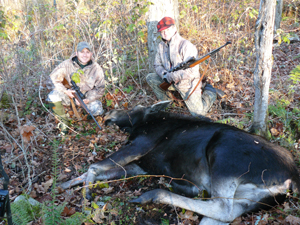

by Paul Lefebvre
BARTON — Halfway through the 2013 season and the moose harvest is running about 40 percent behind last year’s figures at this time, according to biologist Cedric Alexander of the state’s Fish and Wildlife Department.
Early estimates suggest that 115 moose had been taken as of Monday night, said Mr. Alexander, the department’s moose biologist who was at the Barton reporting station Tuesday.
Mr. Alexander attributed the trailing harvest to a reduction in permits — about 30 fewer than were issued a year ago.
A hunter not included in the mid-season report was Chris Manges of West Burke, who shot a 622-pound cow Tuesday in Craftsbury.
Mr. Manges said he shot the moose while hunting alone in a clear-cut near Lowell Mountain, an area he had not scouted prior to the season’s opening day.
“I just sorta stumbled on to her,” he said during a brief interview.
Without a plan of how he was going to get the carcass out of the woods, good luck followed him down the mountain when he ran into a logger close to the spot where he had parked his truck.
“A logger across the road drove up in his skidder and brought it down and loaded it in my truck,” said Mr. Manges, who couldn’t stop smiling while waiting for his picture to be taken. He noted that his birthday also falls on 6/22.
The good news, though, for all wildlife enthusiasts is that the checks biologists are conducting at weigh-in stations for tick infestation suggest the moose herd is in relatively good shape.
Mr. Alexander called the infestation of winter tick larvae moderate, with a few moose showing no infestation during a post-mortem examination.
Biologist check for larva infestation by combing through a moose’s hair at four spots: the base of the skull, below the rib cage, behind the shoulder and around the hip.
It’s the first season biologists in Vermont have checked moose for ticks, after earlier reports from neighboring states of Maine and New Hampshire indicated that moose are dying at an alarmingly high rate.
Ticks are the likely cause, and Mr. Alexander suspects that infestation is highest in areas where the moose population is dense.
He is hoping that a comparison of tick reports from stations around the state may provide him with additional data. He noted the moose density in the state is highest around the Island Pond area.
The eggs from tick larva hatch over the winter, and as many as 150,000 ticks can cover a moose’s body, according to a recent report in the New York Times.
The six-day rifle season for moose that got underway Saturday ends Thursday.
contact Paul Lefebvre at [email protected]
For more free articles from the Chronicle like this one, see our Editor’s Picks pages. For all the Chronicle’s stories, pick up a print copy or subscribe, either for print or digital editions.







